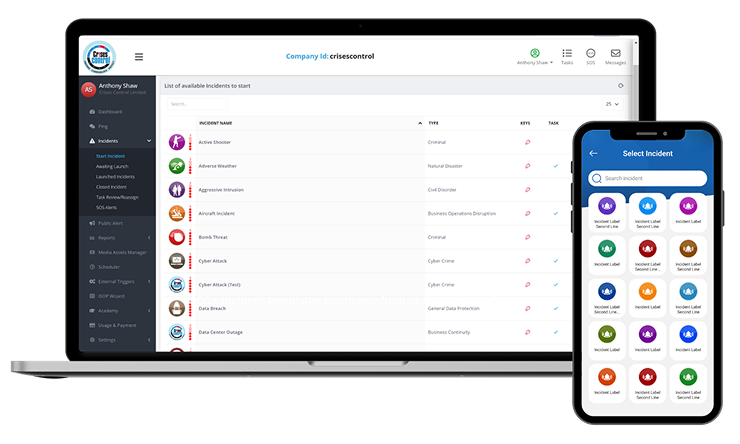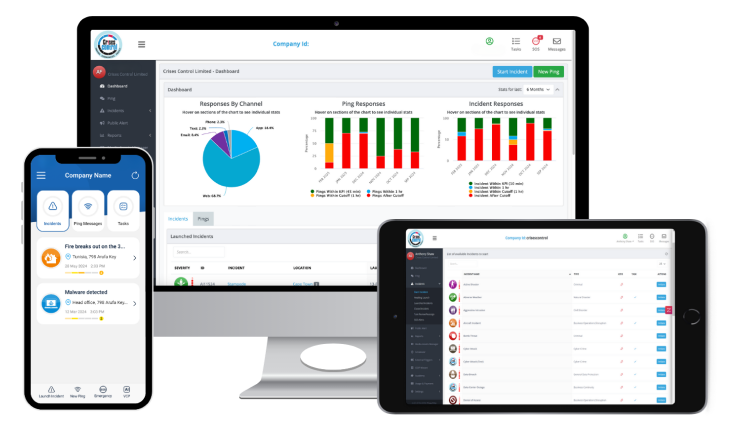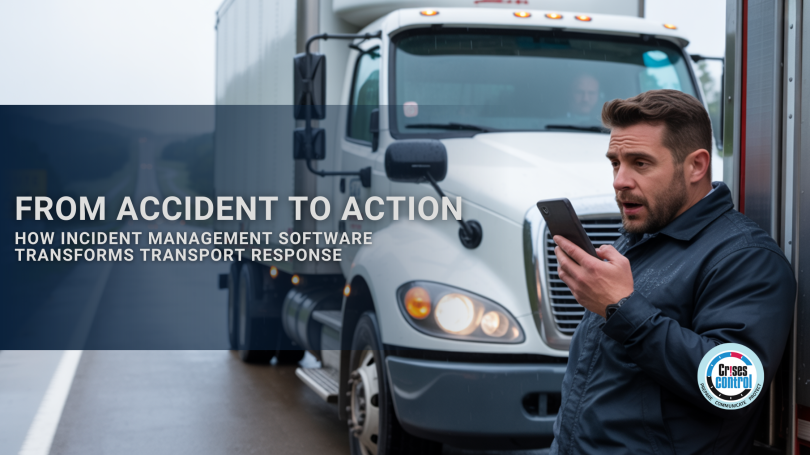Written by Anneri Fourie | Crises Control Executive
Transport and logistics operations involve complex networks of drivers, vehicles, warehouses, and third-party partners. Accidents, breakdowns, or unexpected disruptions can happen at any time, and when they do, every minute counts. A minor collision or mechanical failure might initially seem small, but it can cascade into delayed deliveries, safety hazards, regulatory breaches, and unhappy customers.
Many organisations rely on manual processes to manage incidents, using phone calls, spreadsheets, and emails to coordinate responses. This approach can be slow, error-prone, and stressful. Information is often scattered, updates are delayed, and teams struggle to respond effectively when seconds matter.
Incident management software offers a solution. It provides a centralised platform to log, escalate, and resolve incidents quickly. This article explores the challenges of transport incident management, the benefits of modern software, and how Crises Control can help organisations move from accident to action efficiently.
The Challenges of Managing Transport Incidents
Transport incidents are unpredictable and time-sensitive. Without a clear process, small problems can quickly escalate into serious issues. Some of the most pressing challenges include:
1. Operational Disruptions
A single vehicle breakdown or blocked route can ripple across the supply chain. Operations teams that rely on manual communication often experience delays, missed updates, and unclear instructions. This can disrupt deliveries, increase costs, and frustrate both staff and customers.
2. Safety Risks
Workplace and road incidents pose immediate dangers to drivers, warehouse staff, and contractors. Rapid response is crucial to prevent injuries, secondary accidents, and further damage to vehicles or goods.
3. Regulatory Compliance
Transport operations are subject to numerous regulations, including road safety, health and safety, and hazardous goods standards. Failing to record incidents accurately or respond correctly can lead to fines, legal consequences, and reputational damage.
4. Communication Gaps
Large transport operations often involve teams spread across multiple locations and time zones. Without centralised communication, important information may not reach the right people on time, leading to delayed decisions and fragmented responses.
These challenges underline the need for a solution that centralises communication, automates alerts, and supports regulatory compliance. Incident management software meets these requirements while providing visibility, speed, and structure.
Why Incident Management Software Is Essential
Modern incident management software transforms how transport organisations respond to accidents. By providing a single platform for logging, escalation, and resolution, it ensures teams act quickly and effectively.
Key functionalities include:
1. Real-Time Logging
When an incident occurs, it can be logged immediately through mobile or desktop applications. Details such as location, vehicle, personnel involved, severity, and type of incident are captured automatically. Accurate data ensures that teams respond based on the full picture, not guesswork.
2. Automated Escalation
Critical incidents are routed to the right teams automatically, including operations managers, health and safety officers, or warehouse supervisors. Escalation rules can be tailored to ensure the correct people are alerted immediately, reducing delays and avoiding errors caused by manual processes.
3. Centralised Communication
An emergency incident management platform enables all team members to receive notifications at the same time, whether through app alerts, SMS, email, or voice messages. Drivers, warehouse staff, and control centre personnel stay informed, which speeds up coordination and response.
4. Compliance and Reporting
Software records every action, creating audit-ready documentation. Regulatory bodies require accurate reporting for road accidents, hazardous materials, and safety incidents. Having detailed records stored automatically reduces administrative burden and protects organisations during audits or investigations.
5. Analytics and Insights
Beyond immediate response, software tracks trends and patterns, identifying recurring incidents and operational weaknesses. Insights from analytics allow transport operators to implement preventative measures, improve processes, and enhance overall safety.
How Crises Control Supports Transport Organisations
Crises Control offers a dedicated Incident Manager module designed for transport and logistics operators. It combines fleet accident management, crisis response software, and centralised communication into a single, easy-to-use platform.
1. Speed and Accuracy in Response
When an incident is logged in Crises Control, the right people are notified instantly. Drivers, managers, and safety officers receive updates in real-time, enabling decisions to be made immediately. This rapid response reduces operational downtime and ensures vehicles and goods remain on schedule wherever possible.
2. Coordinated Multi-Team Action
Accidents involving multiple vehicles or sites require a coordinated response. Incident Manager tracks actions across all teams, providing managers with a clear overview of who is doing what, where, and when. This prevents duplication, missed steps, or delayed interventions.
3. Compliance Across Regions
Transport operators often operate across countries or regions, each with specific regulatory requirements. Crises Control maintains a detailed log of all actions and communications, supporting audits and compliance reporting. Organisations can demonstrate regulatory adherence confidently, no matter where the incident occurs.
4. Learning from Every Incident
Analytics within Crises Control help you identify trends, repeat issues, and potential risks. Teams can take proactive measures, adjust procedures, and train staff based on real data. This ensures continuous improvement and reduces the likelihood of similar incidents recurring.

Interested in our Incident Management Software?
The Incident Manager enables you to launch and manage incidents in seconds, leveraging real-time dashboards, task automation, multi-channel alerts, and mobile access to coordinate responses seamlessly across your organisation.
A Real-World Example
Imagine a delivery truck collides with a road obstruction in Europe.
- The driver logs the incident immediately using the Crises Control mobile app, providing details of location, vehicle, and injuries.
- Crises Control automatically notifies the operations centre, warehouse teams, and safety managers.
- Managers reroute other vehicles, communicate delays to clients, and dispatch emergency assistance if required.
- Every step is logged, creating a complete audit trail for compliance, insurance, and future analysis.
Without software, managing this incident could take hours, with scattered communication and missed opportunities to mitigate impact. With Crises Control, teams can respond in minutes, keeping people safe, operations running, and customers informed.
Key Benefits for Transport Operators
Using incident management software provides measurable benefits:
- Reduced Downtime: Immediate logging and escalation minimise disruption and keep supply chains moving, even when accidents occur.
- Enhanced Safety: Rapid alerts and coordinated responses protect staff and drivers from secondary incidents or injury.
- Regulatory Compliance: Time-stamped records and automated reporting make audits straightforward and reduce the risk of non-compliance fines.
- Operational Visibility: Centralised dashboards allow managers to monitor incidents in real-time, track team actions, and make informed decisions quickly.
- Continuous Improvement: Insights from incident data enable organisations to identify recurring issues and improve safety procedures and response protocols.
Choosing the Best Software for Logistics Incident Response
When evaluating transport accident response tools or emergency incident management platforms, consider:
- Multi-Channel Alerting: Can it notify stakeholders instantly via app, SMS, email, Microsoft Teams and voice?
- Automated Escalation: Are escalation rules configurable to reach the right people immediately?
- Regulatory Compliance: Does it automatically maintain audit-ready records?
- Mobile Accessibility: Can drivers and remote teams log incidents easily from anywhere?
- Integration Capabilities: Can it connect with existing fleet management, ERP, or logistics systems for seamless workflows?
Crises Control meets these criteria and provides a platform tailored to complex logistics operations, combining safety, compliance, and operational efficiency.
Conclusion: From Accident to Action
Accidents in transport operations are inevitable, but slow or unstructured responses are not. Incident management software gives teams the tools to respond quickly, coordinate effectively, maintain compliance, and protect people, vehicles, and goods.
Crises Control’s Incident Manager provides a centralised, multi-channel platform that ensures transport incidents are handled efficiently from start to finish. Organisations gain visibility, control, and confidence that incidents are managed safely and effectively.
Take the first step towards faster, safer, and compliant incident response. Contact us today for a free demo and see how Crises Control can help your team move from accident to action.
Request a FREE Demo

